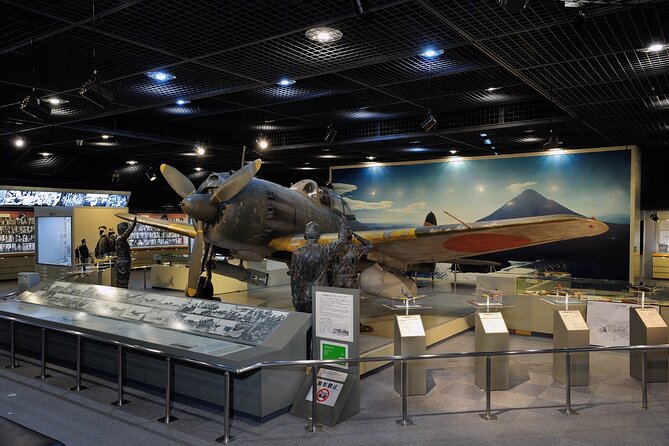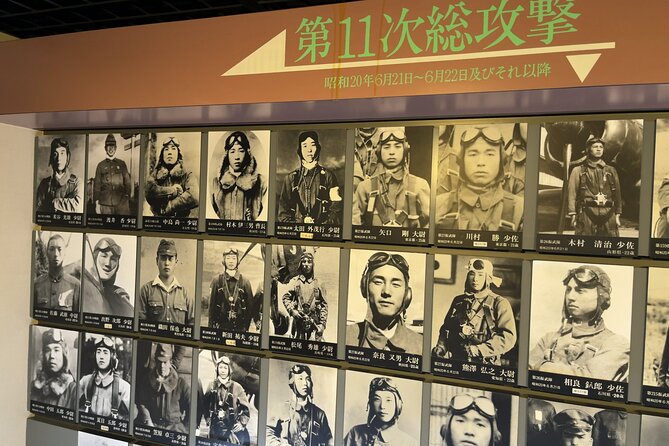The Chiran Peace Museum in southern Japan offers a sobering glimpse into the country’s wartime past. Visitors can explore the personal stories and artifacts of the kamikaze pilots – young men who sacrificed their lives in suicide missions during World War II. This complex and controversial chapter of history reveals the depths of Japan’s nationalist ideology and the emotional toll on families. Understanding the motivations and cultural values that drove these pilots provides profound insights into a bygone era. What lessons can be drawn from this history, and how might it shape our perspectives on war and sacrifice?
Good To Know

- The Chiran Peace Museum offers a unique opportunity to understand the kamikaze pilots’ personal stories and the emotional toll on their families and communities.
- The Kamikaze Departure Point Tour provides an immersive experience, allowing visitors to stand at the pilots’ departure point and gain historical insights.
- The kamikaze legacy is deeply intertwined with Japan’s nationalistic fervor and military culture during World War II, reflecting the country’s spirit and refusal to surrender.
- Examining the kamikaze phenomenon raises ethical questions about the use of young men as human bombs and the psychological impact on the pilots and their families.
- The kamikaze legacy continues to shape modern Japanese national identity and values, highlighting the importance of understanding historical context and cultural nuances.
The Kamikaze Pilots of Chiran
Although their lives were tragically cut short, the kamikaze pilots of Chiran have etched an indelible mark on history. During World War II, these young men volunteered for the ultimate sacrifice, piloting explosive-laden aircraft on suicide missions against Allied naval forces.
Hailing from the Chiran Air Base in Kagoshima, Japan, the kamikazes embodied a fierce nationalist spirit and unwavering loyalty to their country. Their actions, while controversial, exemplified the depth of their convictions and the lengths they were willing to go to defend their homeland.
The legacy of the Chiran kamikazes continues to fascinate and polarize people worldwide.
Find more activities and experiences we've covered in Kagoshima.
Understanding the History and Legacy
The Chiran kamikazes’ history and legacy are deeply intertwined with Japan’s nationalistic fervor during World War II. Driven by a sense of duty and honor, these young pilots willingly sacrificed their lives in suicide attacks against Allied forces.
Their actions, though controversial, have become a symbol of Japan’s unwavering spirit and unwillingness to surrender.
Today, the Chiran Peace Museum preserves their memory, offering visitors a sobering look at this chapter of history.
While the kamikaze program remains a complex and sensitive topic, understanding its historical context is crucial for gaining a deeper appreciation of Japan’s wartime experiences.
Exploring the Chiran Peace Museum

At the heart of the Chiran kamikaze legacy lies the Chiran Peace Museum, a sobering yet enlightening destination that offers visitors a profound glimpse into this chapter of Japan’s wartime history.
The museum’s exhibits explore:
- The young pilots’ personal stories and final letters
- The emotional toll on families and communities
- The philosophical and spiritual beliefs that shaped the kamikaze ideology
- The lasting impact of the kamikaze attacks on Japan’s wartime strategy
- The museum’s role in preserving and honoring the memories of those who sacrificed their lives.
Through this immersive experience, visitors gain a deeper understanding of the complexity and human cost of the kamikaze legacy.
Immersive Tour of the Kamikaze Departure Point
Beyond the sobering exhibits at the Chiran Peace Museum, the immersive tour of the Kamikaze Departure Point offers visitors a chance to stand in the very spot where these young pilots embarked on their final missions.
Located at the Marine Port Kagoshima, the tour guides travelers through the historic departure point, providing insights into the Kamikazes’ legacy.
With a maximum of 15 participants, the air-conditioned tour includes a lunch break.
While not wheelchair accessible, the experience is open to most visitors.
Booking in advance is recommended to secure a spot during the limited opening hours.
Reflecting on the Sacrifices and Heroism
Though the Kamikaze Departure Point tour offers a sobering glimpse into the final moments of these young pilots, it also invites visitors to reflect on the sacrifices and heroism that defined the Kamikazes’ legacy.
Their actions, however controversial, represented:
- An unwavering dedication to their country
- A willingness to put duty above personal preservation
- A profound belief in the power of the kamikaze strategy to turn the tide of war
- A tragic loss of promising young lives in the name of a cause
- A lasting impact on the collective psyche of both Japan and its former adversaries
Insights Into Japanese Military Culture
The Kamikaze Departure Point tour also provides valuable insights into the military culture of Japan during World War II.
Visitors learn about the rituals and traditions that surrounded the Kamikaze pilots, including the importance of honor, duty, and sacrifice.
The tour highlights how the Kamikaze program was a reflection of the deeply ingrained values of the Japanese military, such as unwavering loyalty, stoicism, and a willingness to die for the emperor.
This provides a thought-provoking glimpse into the complex and often misunderstood aspects of Japan’s military history during this pivotal period.
Ethical Considerations and Controversies
Given the Kamikaze pilots’ extreme self-sacrifice, the tour’s portrayal of their actions raises complex ethical questions and controversies.
Key ethical issues include:
- The morality of using young men as human bombs to sacrifice their lives for the war effort.
- The psychological impact on Kamikaze pilots and their families.
- Whether the tour glorifies or memorializes these actions.
- Concerns about minimizing the human cost and tragedy of the Kamikaze program.
- The broader context of Japan’s militarism and wartime atrocities during World War II.
These ethical debates underscore the need for sensitive, thoughtful, and nuanced historical interpretation of this contentious aspect of Japan’s past.
Connecting the Past to the Present
The Kamikaze pilots’ extreme self-sacrifice, while ethically complex, connects to broader societal and cultural legacies that endure in Japan today.
Japan’s warrior traditions, reverence for duty, and emphasis on group identity all contributed to the Kamikaze program.
Although the attacks were controversial, their legacy lives on in Japan’s modern-day emphasis on discipline, honor, and self-sacrifice.
Visitors to Chiran can reflect on this history and consider how it shapes Japanese national identity and values, even decades later.
While the Kamikaze actions remain deeply troubling, their impact on Japan’s psyche and global reputation is undeniable.
Common Questions
Can I Take Photos During the Tour?
Yes, visitors can take photos during the tour. The tour overview states that the experience is not wheelchair accessible, but it is stroller accessible and allows service animals. Photography is generally permitted on the tour.
Is There an Age Limit for the Tour?
There is no age limit for this tour. Children of all ages are welcome, though infants must sit on laps. The tour is accessible to most travelers, with a maximum group size of 15 participants.
Are There Any Dietary Restrictions for the Included Lunch?
The tour includes lunch, but there’s no mention of dietary restrictions. Travelers should contact the local provider in advance to inquire about accommodating any special dietary needs or preferences.
Is the Tour Conducted in English or Japanese?
The tour is conducted in both English and Japanese. Visitors can choose their preferred language when booking the tour, and multilingual guides will lead the experience in the selected language.
How Long Does the Entire Tour Last?
The tour lasts approximately 5 hours, running from 11:00 AM to 4:00 PM or 6:00 PM depending on the day of the week. The specific start and end times may vary, so travelers should confirm with the local provider in advance.
The Sum Up
The legacy of the kamikazes of Chiran offers profound insights into Japan’s wartime ideology and the extreme nationalism that drove young pilots to sacrifice their lives. Visiting the Chiran Peace Museum provides an immersive experience, fostering a deeper appreciation of Japan’s cultural values, military traditions, and the ethical dilemmas surrounding such acts of devotion. Understanding this complex chapter in history can help connect the past to the present and promote meaningful dialogue.
More Tour Reviews in Kagoshima
- Kagoshima 8hr Private Tour With Licensed Guide & Bus (Max 15 Pax)
- Kagoshima Family-Friendly Adventure
- Oshima Tsumugi Kimono Dress Rental From Kagoshima
- Half-day Kagoshima Private Arts and Crafts Cultural Experience
- Rickshaw Tour of Kagoshimas Historical and Cultural Sites
- Kagoshimas Largest Winter Light Display
Looking for something different? Other Kagoshima activities we've written about
- Kagoshima 8hr Private Tour With Licensed Guide & Bus (Max 15 Pax)
- Kagoshima Family-Friendly Adventure
- Oshima Tsumugi Kimono Dress Rental From Kagoshima
- Half-day Kagoshima Private Arts and Crafts Cultural Experience
- Rickshaw Tour of Kagoshimas Historical and Cultural Sites
- Kagoshimas Largest Winter Light Display
- Sakurajima Blessings of the Earth Ride
- 1-Day Private Kagoshima Tour by Car With a Professional Guide
- Shore Excursion Tour From Kagoshima Port
- Kirishima Shrine and Ebino Kogen Trekking Private Tour
- Rejuvenate Your Senses:Sand Steam Bliss & Mysteries of Lake Ikeda
- Japanese Whisky Tour in Kagoshima
